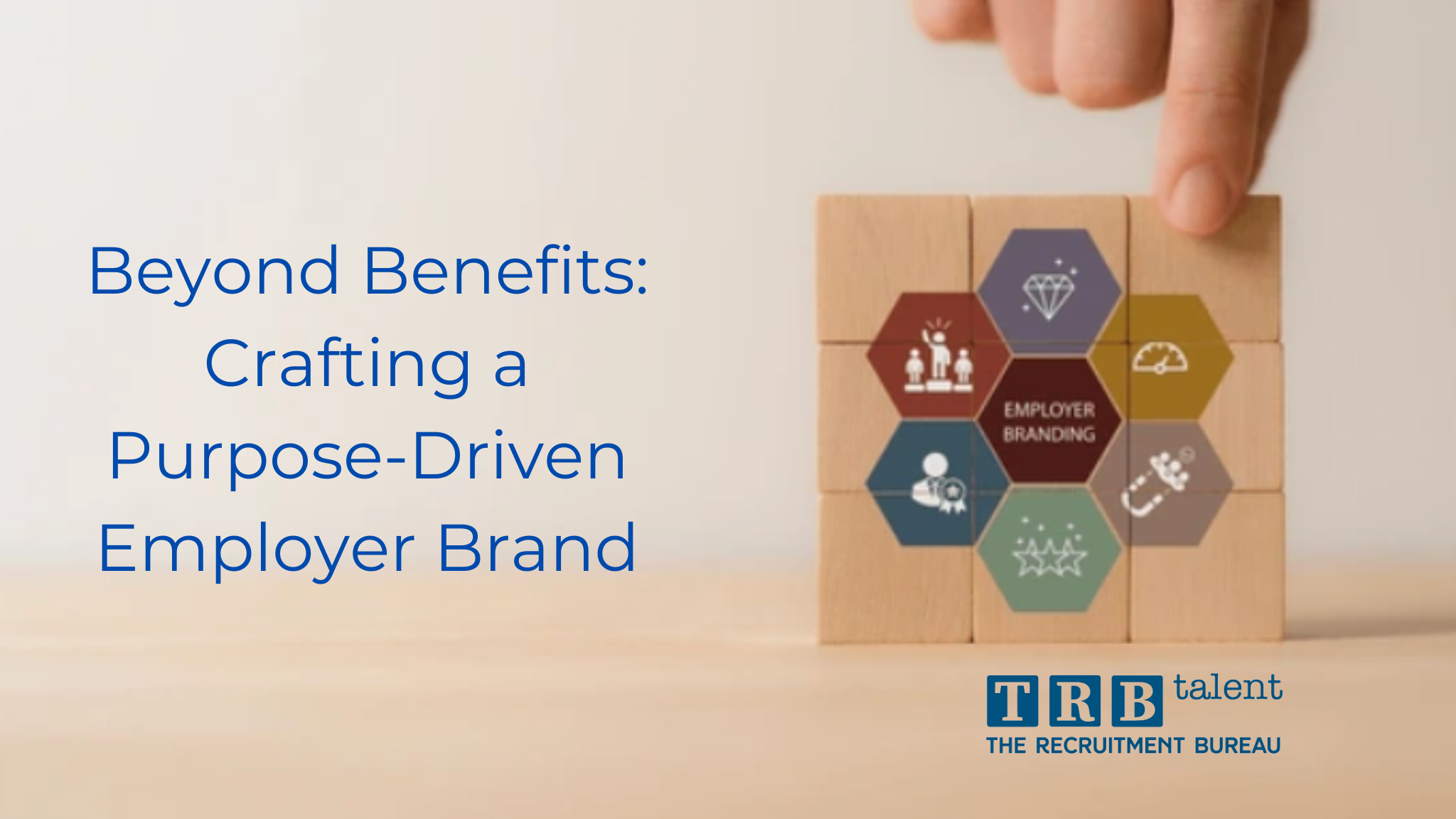Beyond Benefits: Crafting a Purpose-Driven Employer Brand
Talent attraction and acquisition is becoming increasingly complicated in the majority of market sectors and specifically within our Facilities Management division this is perhaps more relevant than most. Skill shortages are constantly growing, and the competition for top talent is fierce.
Beyond that, with more options, employees are becoming more discerning about who they choose to work with.
Companies must do more than offer great salaries and benefits to connect with candidates and retain staff. They need to forge emotional connections with the right people. SHRM found that 86% of HR professionals agree that recruitment is becoming more like marketing today
In today’s world, developing a strong employer brand isn’t just about differentiating your company from the competition; it’s about giving yourself the tools to reduce complexities, reduce staff turnover, and stay resilient.
What is an Employer Brand?
An employer brand encompasses the complete value and experience companies offer employees and job candidates. Essentially, your employer brand answers, “Why should someone choose to work for your company?”
Today, 76% of candidates consider a company’s reputation before applying for a role, and many employees say they would consider leaving their current role to pursue a job with a company with a stronger, more positive reputation.
Like a commercial brand, an employer brand is made up of various elements:
- Company culture and values: The working environment you offer employees and your focus on factors like innovation, collaboration, diversity, or employee growth.
- Working conditions: The factors that affect employees’ day-to-day experiences with your company, such as your approach to work-life balance and team dynamics.
- Career development: Your ability to invest in the growth and development of employees with training, mentorship, courses, and other programs.
- Compensation and benefits: The competitive packages you offer staff members include salaries and other benefits, such as flexible work.
- Reputation and market position: Your reputation in the market is based on, for example, your DEI approach, integrity, social responsibility, or commitment to innovation.
- Employee experience: How you nurture and maintain positive employee experiences by caring for their well-being and helping them achieve their goals.
Why Employer Branding Matters for Small Businesses
According to the MRINetwork, 69% of candidates would reject a job offer from a company with a poor employer brand, even if they were unemployed. Effective branding is crucial for small businesses that may already struggle to stand out in a sea of larger competitors.
Investing in your employer brand can deliver benefits such as:
Greater Cost Efficiency
With tighter budgets, most small businesses must be more strategic about attracting and acquiring talent. According to Harvard Business Review, a negative reputation can be enough to increase your cost per hire by 10%.
Alternatively, a well-crafted employer brand that emphasises the unique benefits and experiences your company can offer employees can significantly reduce recruitment costs. It can help you attract candidates who resonate with your customer’s message, improve the quality of your hires, and reduce recruitment mistakes.
Effective employer branding can also reduce the time it takes to convert a candidate into an employee and improve their chances of staying with your business for longer. Greater retention rates mean you spend less on constantly filling gaps in your team and training new employees.
A Stronger Competitive Advantage
89% of HR leaders agree that a strong employer brand gives them a crucial competitive advantage when attracting top talent. When fighting against larger organisations with more resources for the best candidates, an excellent brand can give you an edge.
It’s your chance to highlight what makes your company unique, such as excellent team dynamics, hands-on learning opportunities, or a focus on diversity and inclusion.
Smaller businesses have a few unique advantages when it comes to employer branding. Often, employees have more direct access to leadership, paving the way for a stronger sense of community and more transparent communications.
Additionally, smaller organisations are often more agile. They can adapt quickly to market changes and trends, implement feedback faster, and adjust their company culture and processes based on team needs without high training and development costs.
Improved Employee Engagement and Retention
A good employer brand directly impacts the experience your staff members have with your company. Building an attractive employer brand means investing in a supportive company culture, excellent training and development opportunities, robust feedback loops, and employee well-being.
All these factors lead to greater staff satisfaction when employees join your team. Additionally, because your employer brand will help you to attract candidates who share your values and vision, these team members are more likely to be invested in their role.
This can lead to higher productivity levels and reduced retention rates. Employees who appreciate and value your employer brand can even help you attract new talent through advocacy programs, positive reviews, and referrals.
Creating Your Employer Brand Strategy
Developing a strong employer brand is crucial to ensuring your company can thrive in a competitive industry and access the talent it needs to grow. Here’s how you can start building a brand that connects with candidates.
- Audit Your Current Position
First, get to know your current reputation as an employer. Conduct employee surveys and exit interviews for honest insights into your current approach’s strengths and weaknesses. Ask team members what they like and dislike about your company regularly, even if you only encourage them to send anonymous feedback.
Build on direct feedback by reading reviews on hiring platforms like Glassdoor and reviewing what current and previous staff members say about your business. It’s also worth analysing your recruitment metrics and hiring success rates. Identify how long it takes to hire an employee and how frequently turnover happens.
- Define Your Employee Value Proposition (EVP)
Next, consider how you can encourage employees to work for your company. Defining your Employee Value Proposition (EVP) involves identifying the benefits, opportunities, and unique experiences you can offer employees to convince them to join your team.
Do you offer comprehensive development opportunities to staff members, with training programs and mentorship? What’s your company culture like? Does it prioritise supportive teams, diversity, equity, inclusion, flexibility, or work-life balance?
Remember to consider your compensation and benefits packages carefully, too.
Are your salaries competitive based on industry benchmarks?
Can you add extra value to the mix through bonuses, health benefits, or flexible work?
- Develop Your Brand Message
With a clear view of your current employer brand and your EVP in place, you can craft a brand message that resonates with potential employees. Consider it your “elevator pitch” describing why candidates should choose you.
Think about the tone and voice of your employer communications based on how you want to appear to potential employees. Consistency is key in choosing a friendly, casual tone or a more formal, corporate approach. This tone should align with your company’s values and overall brand identity.
Think about how you’ll share your message across platforms (your website, job sites, and even social media platforms) and enhance it with additional assets, such as team photos and videos. Remember to tailor your message to different segments of your “ideal employee group”, adjusting to suit their priorities and interests.
- Implement and Activate
Now, it’s time to start bringing your employer brand to life. Begin by training your hiring managers and HR teams, giving them insights into effectively communicating your brand elements. Update your recruitment materials, such as your job descriptions and career page, to reflect the core elements of your employer brand.
Everything you use to attract and connect with candidates should remind them of the unique value they can get from working with your company. Think about how to advertise your employer brand as effectively as possible on channels like LinkedIn, professional networks, and industry forums.
Activating your existing employees to help you share insights into your employer brand with the world can be helpful, too. Please encourage them to share their experiences on social media, attend recruiting events, or create content to share on your website.
- Measuring Success
Finally, ensure you have a strategy to track the success of your employer brand in your recruitment efforts. Gathering feedback from employees is a suggested first step. It’s also worth looking at key metrics and KPIs, such as:
- Application rates and quality
- Cost per hire
- Time to fill positions
- Retention rates
- Employer review ratings
- Referral rates
- Social media engagement
- Employee satisfaction scores
Tracking these metrics and regularly asking your team members for insights into how you can improve your employer brand will help you strengthen your reputation over time. The more you invest in constantly refining your employer brand, the more you’ll be able to build a workplace candidates are keen to join.
Employer Branding: Quick Best Practices for 2025
There are a few additional tips and best practices to remember when developing an employer brand in 2025. Based on the current needs and expectations of top candidates, make sure you:
- Take a digital-first approach: Maintain an engaging online presence, use video to share insights into your workplace, and create immersive candidate experiences.
- Activate your employees: Ask employees to share real, authentic stories about their experiences with potential candidates.
- Maintain consistent communication: Listen to your employees, address their challenges, and use their feedback to improve your brand.
- Invest in employee satisfaction: Constantly look for new ways to delight your employees with training opportunities, flexible work options, and wellbeing initiatives.
In 2025, as skill shortages increase and retention rates continue to drop, building a compelling employer brand is more important than ever. By following the framework outlined above and leveraging the unique advantages you can offer your employees, you can boost your chances of attracting and retaining the talent you need to grow.
About TRBtalent FM
TRBtalent are specialist recruiters with hands-on experience within the FM sector. We recruit technical and non-technical positions at all levels within the sector. We support FM companies, In-house teams and Subcontractors to find the skilled talent they are looking for. With our dedicated proactive search and selection on all assignments, we find top performers across the UK.
All placements come with our 12 Month Rebate and Replacement Policy as standard on all roles filled. To find out more call 01622 934 954, fill out our online form, or contact Jeremy Barwick directly at Jeremy@TRBtalent.co.uk



